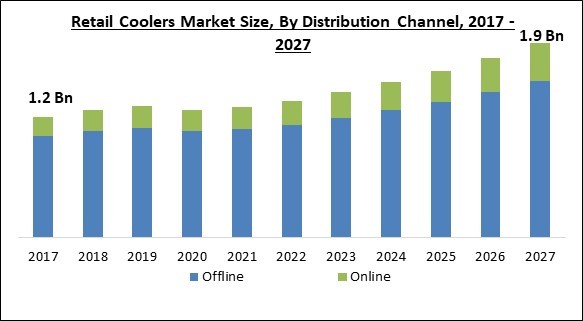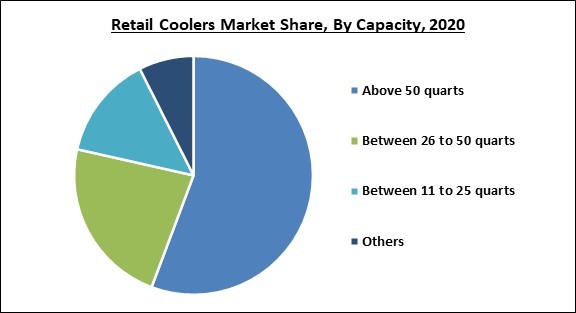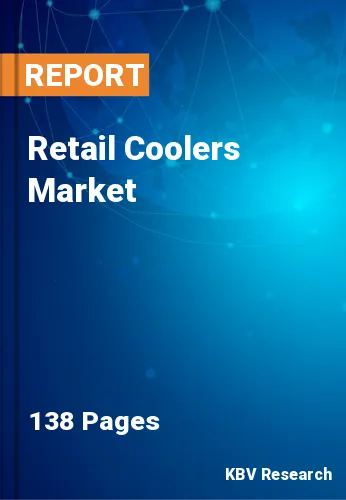The Global Retail Coolers Market size is expected to reach $1.9 billion by 2027, rising at a market growth of 6.9% CAGR during the forecast period.
A retail cooler is a self-contained or remote-condensing appliance that employs a vapor-compression refrigeration system and is developed for food and beverage storage in order to protect the product contamination by keeping products at a consistent temperature.
Evaporators and condensers are used in these coolers to keep the internal storage space cold. The foodservice industry is the primary user of these industrial coolers. Picnics, fishing trips, long drives, and boating, are some of the activities in which these coolers can be carried. In addition, these coolers offer immense convenience in activities like camping and trekking.
It is most commonly filled with ice cubes to keep the goods inside, cold. Ice packs are occasionally utilized because they either keep the melting water within or have a gel inside that keeps it colder for longer than plain ice. In warmer summers, they can also be used to transport chilled groceries or food products, for example preventing ice cream from melting in a vehicle. Even without the ice, this can be beneficial, especially if the ride home is long. Cup holders are also integrated into the lids of some coolers.
Reach-in coolers with bottom-mounted compressors may make it convenient to keep the environment of the cooler, colder. Additionally, reach-in coolers with compressors at the top, on the other hand, are less likely to accumulate dust and become clogged.

The COVID-19 led the world to a very critical environment in terms of economy and healthcare. Many businesses were demolished due to the advent of this pandemic. In addition, the COVID-19 pandemic also caused a significant inconvenience in the day-to-day life of people across the world. Moreover, the COVID-19 pandemic also affected the retail cooler market. The major factor that led the market to a downfall was the lockdown that was enforced by the government with the purpose to regulate the diffusion of the infection. Due to the lockdown, the manufacturing units of various goods, including retail cooler, went under a temporary closure. The supply chain of the product was substantially hampered.
Further, the COVID-19 outbreak had an adverse impact on the demand for retail coolers primarily from the hospitality industry. One of the most major changes in recent months has been the shutdown of non-essential goods and services, which had a negative impact on the food-service industry.
In the era of rapid urbanization, people are constantly focusing on making their lifestyles more enhanced and convenient. Due to this reason, the consumption of frozen food, such as frozen peas and frozen meat, is rapidly emerging as a trend across the world. Frozen food is kept at an immensely low temperature from the time it was made till the time it is consumed. This process is done in order to preserve the food for a long time. Moreover, frozen food items are widely available across the market in form of packaged food.
Due to the increased demand for packaged frozen food, the availability of these food items across the market is increased. In addition, these products are widely available in grocery stores and general stores as well.
Retail coolers consume a lesser amount of energy in comparison to traditional and massive refrigerators. Due to the fact that these coolers are much smaller than the regular commercial refrigerators, retail coolers work on a smaller portion of energy. In addition, the increasing concerns about the conservation of energy are accelerating the demand for energy-efficient appliances that can also save cost on electricity bills. In addition, retail coolers would be majorly demanded by small-scale stores and shops due to the lesser consumption of electricity. Owing to the enhanced portability, retail coolers are significantly being utilized by street vendors in order to keep their items cold for a long duration of time in any weather.
The ability to keep food products at the proper temperature is a key reason for the increasing demand for retail coolers. However, a major factor affecting demand for these coolers is the high initial cost of the retail coolers. Expenses that occur in the deployment of retail coolers are much higher. In addition, the increased installation cost of retail coolers is a substantial hurdle for small-sized business owners and shopkeepers. Additionally, the maintenance cost to these coolers is also high owing to the fluctuating equipment prices of the product. Along with that, there are a few risks that are associated with the product, such as condenser failure. The cost that incurs in the repairing of a damaged condenser is significant and cannot be afforded by numerous small store owners.

Based on Distribution Channel, the market is segmented into Offline and Online. In 2020, the online segment recorded a significant revenue share of the retail coolers market. The growth of this segment is owing to the convenience that is offered by the online shopping mode. The buyer can go through a broad range of products from all over the world and from different manufacturers with just few clicks and can compare one product with another. Moreover, in the online mode of shopping the customer can also experience doorstep delivery in a short period of time.
Based on Capacity, the market is segmented into Above 50 quarts, Between 26 to 50 quarts, Between 11 to 25 quarts, and Others. In 2020, the above 50 quarts garnered the largest revenue share of the retail coolers market. These retail coolers with greater capacity are ideal for long road trips, camping trips, and sporting activities. Additionally, the cooler is frequently built with heavy-duty wheels so that it can be rolled through rugged terrain while fully laden. A 50-60pint cooler is perfect for holding all foods and drinks in the weekend camping scenario for big travel groups.
| Report Attribute | Details |
|---|---|
| Market size value in 2020 | USD 1.2 Billion |
| Market size forecast in 2027 | USD 1.9 Billion |
| Base Year | 2020 |
| Historical Period | 2017 to 2019 |
| Forecast Period | 2021 to 2027 |
| Revenue Growth Rate | CAGR of 6.9% from 2021 to 2027 |
| Number of Pages | 138 |
| Number of Tables | 259 |
| Report coverage | Market Trends, Revenue Estimation and Forecast, Segmentation Analysis, Regional and Country Breakdown, Companies Strategic Developments, Company Profiling |
| Segments covered | Product, Distribution Channel, Region |
| Country scope | US, Canada, Mexico, Germany, UK, France, Russia, Spain, Italy, China, Japan, India, South Korea, Singapore, Malaysia, Brazil, Argentina, UAE, Saudi Arabia, South Africa, Nigeria |
| Growth Drivers |
|
| Restraints |
|
Based on Regions, the market is segmented into North America, Europe, Asia Pacific, and Latin America, Middle East & Africa. In 2020, Europe procured a substantial revenue share of the retail coolers market. In Europe, the increasing number of people that are consuming liquor is one of the major reasons that are surging the demand and growth of the retail coolers market. Moreover, the rising trend of fishing across this region is also accelerating the demand for retail coolers.
Free Valuable Insights: Global Retail Coolers Market size to reach USD 1.9 Billion by 2027
The market research report covers the analysis of key stake holders of the market. Key companies profiled in the report include Polar Bear Coolers, ORCA (Outdoor Recreation Company of America), LLC, Plastilite Corporation, Bison Coolers, Grizzly Coolers, LLC, Huntington Solutions, LLC, ICEE Containers Pty Ltd., Yeti holdings, Inc., and Newell Brands, Inc.
By Distribution Channel
By Capacity
By Geography
The retail coolers market size is projected to reach USD 1.9 billion by 2027.
Rising trend of frozen food are driving the market in coming years, however, high cost of the product limited the growth of the market.
Polar Bear Coolers, ORCA (Outdoor Recreation Company of America), LLC, Plastilite Corporation, Bison Coolers, Grizzly Coolers, LLC, Huntington Solutions, LLC, ICEE Containers Pty Ltd., Yeti holdings, Inc., and Newell Brands, Inc.
The Offline segment is leading the Global Retail Coolers Market by Distribution Channel 2020, and would continue to be a dominant market till 2027.
The North America is the fastest growing region in Global Retail Coolers Market by Region 2020.
Our team of dedicated experts can provide you with attractive expansion opportunities for your business.

